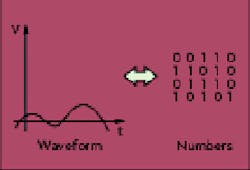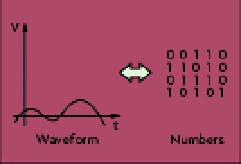Analog I/O is discretely valuable
To be meaningfully recorded or manipulated by a computer, says the paper, analog measurements such as pressure, temperature, flow rate, and position must be translated into digital representations. Inherently digital events such as the tripping of a motor also must be interpretable as a transistor-to-transistor logic (TTL) level changes in voltage.
Most sensors for measuring temperature, pressure, and other continuous variables provide a continuously varying electrical output to represent the magnitude of the variable. To make this signal usable by a microprocessor, it must be converted to a discrete, digital number.
This analog-to-digital (A/D) conversion process poses two primary challenges: quantization and sampling in time. Quantization is the uncertainty introduced on conversion of an analog voltage to a digital number. Measurement transducers or transmitters typically provide continuously varying signals between 0-10 VDC, ±5 VDC, 0-100 mVDC, or 4-20 mADC. Thermocouples and resistance temperature devices (RTDs) are other common, low-voltage inputs.
When this analog value is represented as a digital number, however, this essentially continuous resolution is limited to discrete steps. Resolution of A/D conversion often is stated in bits—the more bits the finer the resolution. The number of bits also determines the number of divisions into which a full-scale input range can be divided to approximate an analog input voltage. For example, 8-bit resolution of a 0-10 V input signal means that the range is divided into 28 or 256 steps. This yields a step, or interval, size of 10 V/256 = 0.039 V. A 10-V input is equal to the digital number 255 and a 0-V input corresponds to 0. Each 0.039-V change in the input is indicated by adding or subtracting 1 from the previous number, so 9.961 V is digitally represented as 254.
The paper reminds us that digital data acquisition systems also parcel time into discrete intervals. There really is no information about the behavior of the variable between data points gathered. Special precautions are needed to prevent meaningful data loss, so the interpolation between recorded points will remain a valid assumption.
The Nyquist Theorem defines the necessary relationship between the highest frequency contained in a signal and the minimum required sampling speed. Nyquist stated the sample rate must be at least twice the highest frequency component contained in the input signal. To sample a 1-Hz sine wave, the sample rate should be at least 2 Hz. But a rate of 8-16 Hz would be much better for resolving the true shape of the wave.
The primary implications of ignoring the Nyquist criterion include missing high frequency information and introducing aliasing. If the sample rate isn’t sufficient, the presence of nonexistent frequencies might be indicated. Aliasing makes helicopter rotors or car wheels appear to turn slowly backwards in movies. Low-pass or anti-aliasing filters can be used to limit the measured waveform’s frequency spectrum, so that no detectable component equals or exceeds half of the sampling rate.
Designing or specifying a device for A/D conversion consists of a series of tradeoffs. More resolution means more accurate conversion but more expensive hardware. Similarly, slower sample rates mean cheaper A/D conversion, but the Nyquist criterion must still be satisfied.
On the analog I/O product front, the eAutomation Group of Advantech introduced its PCI-1727U analog output PCI card featuring 12 analog output channels with DB-37 connector. The PCI card is capable of outputting ±10 V and 0~20 mA current loops with 14-bit resolution. It’s equipped with 16 TTL DI and 16 TTL DO channels that are suitable for industrial control applications and a universal PCI bus compatible with both 3.3 V and 5 V signaling.
The ISA-compatible card uses the same software API as ISA cards, so there’s no need to rewrite programming when upgrading. The PCI-1727U features synchronized analog output function allowing multiple devices to be driven simultaneously without any synchronization lags.
New from Opto 22 are the Snap AIMA and AIV 32-channel analog current and voltage input modules. These new high-density modules, designed for use with Opto 22 Snap PAC systems, are part of the company’s widely deployed Snap family of I/O modules used to connect to and communicate with analog sensors and devices in industrial applications.
The increased density of the modules—eight times greater than that of standard four-channel Snap modules—reportedly can effectively reduce the per point cost of applications in which they’re deployed by up to 400%, while also reducing the required panel for those applications with high I/O point counts.




